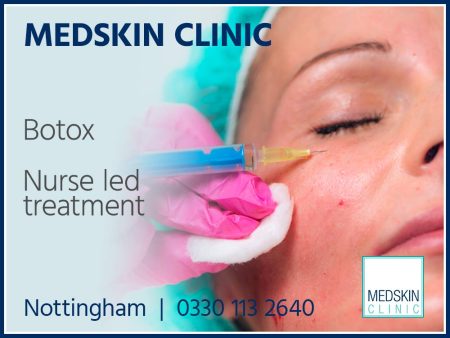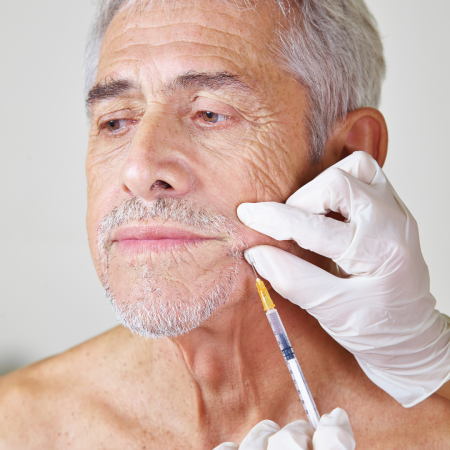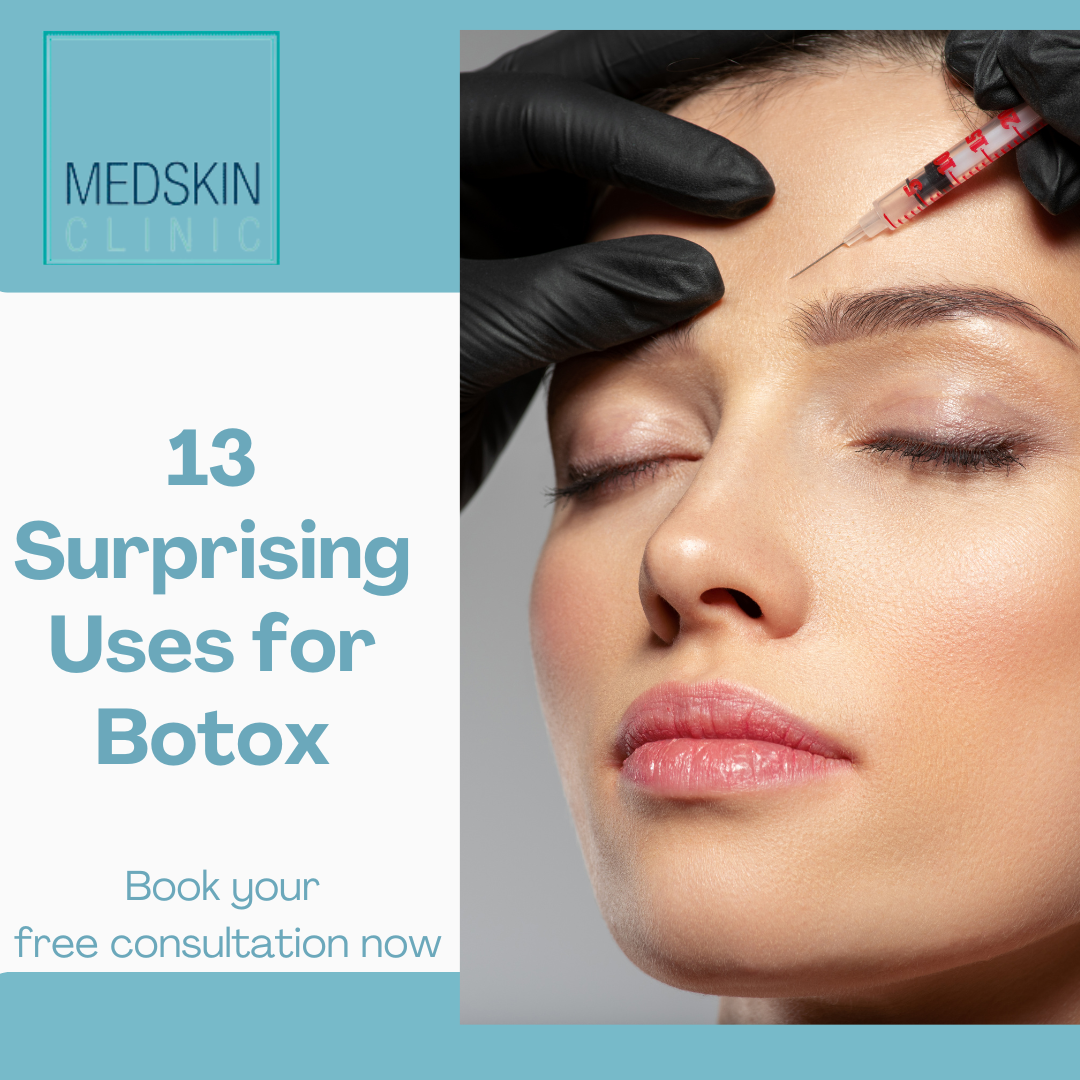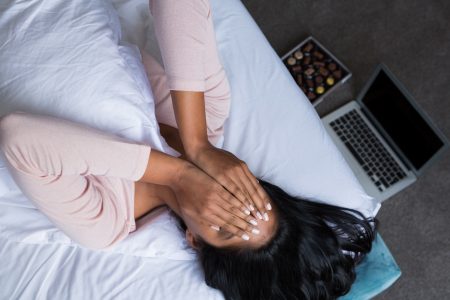13 Surprising Uses For Botox
Botox, or botulinum toxin, is primarily known for its cosmetic use to reduce wrinkles and fine lines by temporarily paralysing muscles. However, there are several surprising and lesser-known uses for Botox in medical and non-cosmetic fields:
1. Migraine Treatment: Botox has been approved by the FDA for the treatment of chronic migraines. It is injected into specific head and neck muscles and can help reduce the frequency and severity of migraine headaches.
2. Hyperhidrosis: Botox can be used to treat excessive sweating (hyperhidrosis) by blocking the nerves that stimulate sweat glands. It’s commonly used in the armpits, palms, and soles of the feet.
3. Bruxism: Botox injections can help alleviate teeth grinding (bruxism) by relaxing the jaw muscles. This can reduce the wear and tear on teeth and alleviate associated jaw pain.
4. Eye Twitching (Blepharospasm): Botox can be used to treat involuntary eyelid twitching and spasms, a condition known as blepharospasm. It helps relax the muscles around the eyes.
5. Overactive Bladder: Botox injections into the bladder muscle can help manage symptoms of an overactive bladder, reducing urinary urgency and frequency.
6. Vocal Cord Disorders: Botox can be used to treat certain vocal cord disorders, such as spasmodic dysphonia, by relaxing the muscles responsible for voice production.
7. Bell’s Palsy: In some cases of Bell’s palsy, where facial muscles become weak or paralysed, Botox injections can help relax the unaffected side of the face, creating a more balanced appearance.
8. Depression: There is ongoing research into the use of Botox for treating depression. Some studies suggest that the temporary paralysis of facial muscles can affect mood and emotional expression positively.
9. Achalasia: Botox can be injected into the lower oesophagal sphincter to help relax it, making it easier for food and liquids to pass into the stomach. This can provide temporary relief for achalasia, a swallowing disorder.
10. Muscle Stiffness and Spasms: Botox is used to treat various muscle-related conditions, including cervical dystonia (neck muscle spasms), limb spasticity after stroke, and muscle stiffness in conditions like cerebral palsy.
11. Cosmetic Jaw Contouring: Botox can be used to reshape the jawline by injecting it into the masseter muscles, reducing their size and creating a more refined facial appearance.
12. Scar Reduction: Botox can be injected into scars to help reduce their appearance by relaxing the surrounding muscles and minimising tension on the scar tissue.
13. Crossed Eyes (Strabismus): Botox can be used as a temporary treatment for strabismus by weakening the overactive eye muscles, allowing the eyes to align properly.
Botox Injections Nottingham, Newark, Lincoln and Chesterfield
These surprising uses for Botox highlight its versatility beyond its well-known cosmetic applications. However, it’s essential to consult a qualified healthcare professional before considering any Botox treatment to determine its suitability for your specific condition and to ensure safe administration. All of our Nurses and qualified and fully trained in the administration of Botox. We offer free consultation in each of our clinics, simply contact us here or call 0330 113 26 40
Can Botox Really Help Migraines?
Botox (botulinum toxin) can be an effective treatment for chronic migraine headaches. Chronic migraines are defined as experiencing headaches on 15 or more days per month, with each headache lasting at least four hours. Here’s how Botox helps in managing chronic migraines:
1. Muscle Relaxation: Botox works by blocking the release of neurotransmitters that signal muscle contractions. When it is injected into specific muscles in the head and neck region, it temporarily paralyses or relaxes those muscles. In the context of migraine treatment, it primarily targets the muscles around the forehead, temples, and the back of the neck.
2. Reduced Muscle Tension: Many people with chronic migraines experience tension and muscle contraction in the head and neck, which can contribute to the onset and persistence of migraines. Botox injections reduce this muscle tension, helping to alleviate migraine triggers.
3. Pain Signal Inhibition: Botox may also inhibit the transmission of pain signals from the nerves to the brain. By interfering with the communication between nerves and muscles, it can reduce the intensity of migraine pain.
4. Preventative Effect: Botox is used as a preventative treatment for migraines. It is not a pain reliever that is used when a migraine attack is already in progress. Instead, it is administered every 12 weeks or so to reduce the frequency and severity of migraine attacks over time.
5. Duration of Effect: The effects of Botox injections for migraine prevention typically last for about 12 weeks. After this period, the treatment needs to be repeated to maintain its effectiveness.
It’s important to note that Botox is generally considered for individuals who have not responded well to other migraine treatments or who experience intolerable side effects from those treatments. The decision to use Botox for migraines should be made in consultation with a healthcare professional, such as a neurologist or headache specialist, who can evaluate your specific condition and determine whether Botox is a suitable option for you.
Additionally, not everyone with chronic migraines will benefit from Botox, and the response to treatment can vary from person to person. Some individuals may experience significant reductions in migraine frequency and severity, while others may have only partial relief or no response at all. Therefore, the effectiveness of Botox for migraine prevention should be assessed on an individual basis.
 Stop Excessive Sweating with Botox
Stop Excessive Sweating with Botox
Botox (botulinum toxin) is also used to treat excessive sweating, a condition known as hyperhidrosis. Here’s how Botox helps in managing excessive sweating:
1. Blocking Sweat Gland Activation: Excessive sweating occurs when sweat glands become overactive and produce more sweat than the body needs to regulate its temperature. Botox works by blocking the signals from nerves that stimulate sweat gland activity. When injected into the skin, Botox disrupts the communication between nerves and sweat glands in the treated area.
2. Temporary Effect: Botox’s effect on sweat glands is temporary, typically lasting for several months. The exact duration can vary but generally ranges from 4 to 12 months. After this period, the nerve signals gradually return, and the sweat glands become active again.
3. Targeted Treatment: Botox is administered via multiple injections in the affected area, such as the underarms (axillary hyperhidrosis), palms of the hands (palmar hyperhidrosis), or soles of the feet (plantar hyperhidrosis). The injections are distributed evenly to cover the entire treatment area.
4. Reduction in Sweating: Once Botox takes effect, it reduces excessive sweating in the treated area by preventing sweat glands from producing sweat. This can significantly improve the quality of life for individuals who experience social discomfort, embarrassment, or other issues related to excessive sweating.
5. Maintenance Injections: To maintain the reduction in sweating, individuals typically need repeat injections of Botox every few months. The frequency of maintenance injections can vary among individuals and may be adjusted based on the specific response to treatment.
6. Non-Cosmetic Application: Botox for hyperhidrosis is considered a medical treatment, not a cosmetic one. It is a well-established and approved therapy for individuals who find that excessive sweating interferes with their daily activities and quality of life.
7. Minimised Side Effects: One of the advantages of using Botox for hyperhidrosis is that it has fewer systemic side effects compared to some other treatments for excessive sweating, such as oral medications. The side effects are generally limited to the injection site and may include temporary discomfort, bruising, or muscle weakness in the treated area.
Before undergoing Botox treatment for hyperhidrosis, it is essential to consult with a healthcare professional, often a dermatologist or a physician experienced in administering Botox for medical purposes. They can evaluate your condition, discuss the potential benefits and risks, and determine the appropriate treatment plan for your specific case.
 How to Stop Teeth Grinding
How to Stop Teeth Grinding
Botox (botulinum toxin) can be used to treat bruxism, a condition characterised by grinding or clenching of the teeth, often involuntarily, which can lead to dental damage, jaw pain, and other symptoms. This treatment is being sought by more and more male patients in particular. Here’s how Botox helps in managing bruxism:
1. Muscle Relaxation: Botox is injected into the muscles responsible for jaw clenching and grinding, typically the masseter muscles located on the sides of the jaw. By doing so, Botox temporarily weakens or relaxes these muscles.
2. Reduced Grinding Force: The relaxation of the masseter muscles makes it more challenging for the patient to clench or grind their teeth forcefully. This can help protect the teeth from excessive wear and damage.
3. Pain Relief: Bruxism often leads to jaw pain, headaches, and facial discomfort. By reducing muscle tension and forceful grinding, Botox can alleviate these symptoms in patients with bruxism.
4. Preventive Measure: Botox for bruxism is considered a preventive measure rather than a cure. It does not treat the underlying causes of bruxism, such as stress or misaligned teeth, but it can help manage the consequences by reducing the impact of teeth grinding.
5. Duration of Effect: The effects of Botox for bruxism typically last for about three to four months. As the effects wear off, the muscles gradually regain their normal function, so repeat injections are necessary to maintain the desired results.
6. Suitability for Male Patients: Botox treatment for bruxism is suitable for both male and female patients who experience bruxism-related symptoms. The effectiveness of the treatment is not gender-specific.
7. Customised Treatment: The dosage and injection sites for Botox in patients with bruxism will be determined by a qualified healthcare provider based on the individual’s anatomy and the severity of their condition.
8. Safety Profile: Botox injections for bruxism have a well-established safety profile. The side effects are generally mild and limited to the injection site, such as temporary bruising or soreness.
9. Consultation: If you are experiencing bruxism and considering Botox treatment, it is important to consult with a qualified healthcare provider, such as a dentist or oral and maxillofacial surgeon, who has experience with this procedure. They can assess your specific condition, discuss the potential benefits and risks, and develop a personalised treatment plan.
It’s worth noting that Botox for bruxism is most effective when used in conjunction with other approaches to address the underlying causes of bruxism, such as stress management, relaxation techniques, or dental appliances like mouthguards or splints, especially if bruxism is related to dental issues like misalignment.
Botox Treatment Nottingham, Lincon, Newark and Chesterfield
Medskin’s nurse-led clinics in Nottingham, Lincoln, Newark, and Chesterfield provide expert services with a focus on patient well-being. With a dedicated team of qualified nurses, they offer a range of treatments and care options to meet your needs.
If you’re seeking professional Botox administration, skincare, or consultations in these areas, don’t hesitate to reach out to Medskin at 0300 113 2640. Take the first step towards a healthier and more vibrant you with Medskin’s trusted and compassionate team. Your well-being is their priority. Contact us today to schedule an appointment and experience the difference in personalised healthcare.



